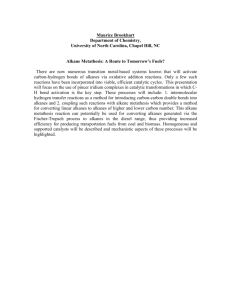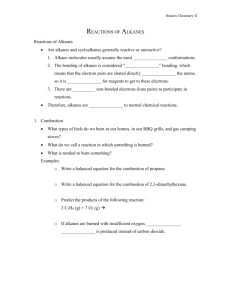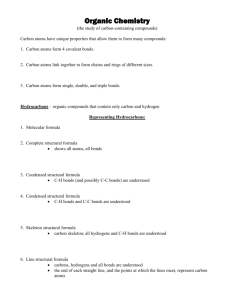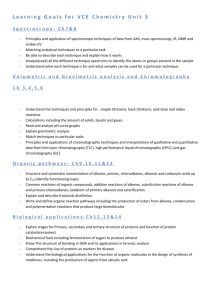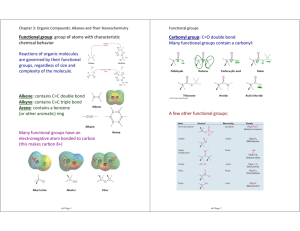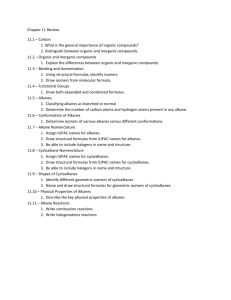revised hydrocarbons alkanes
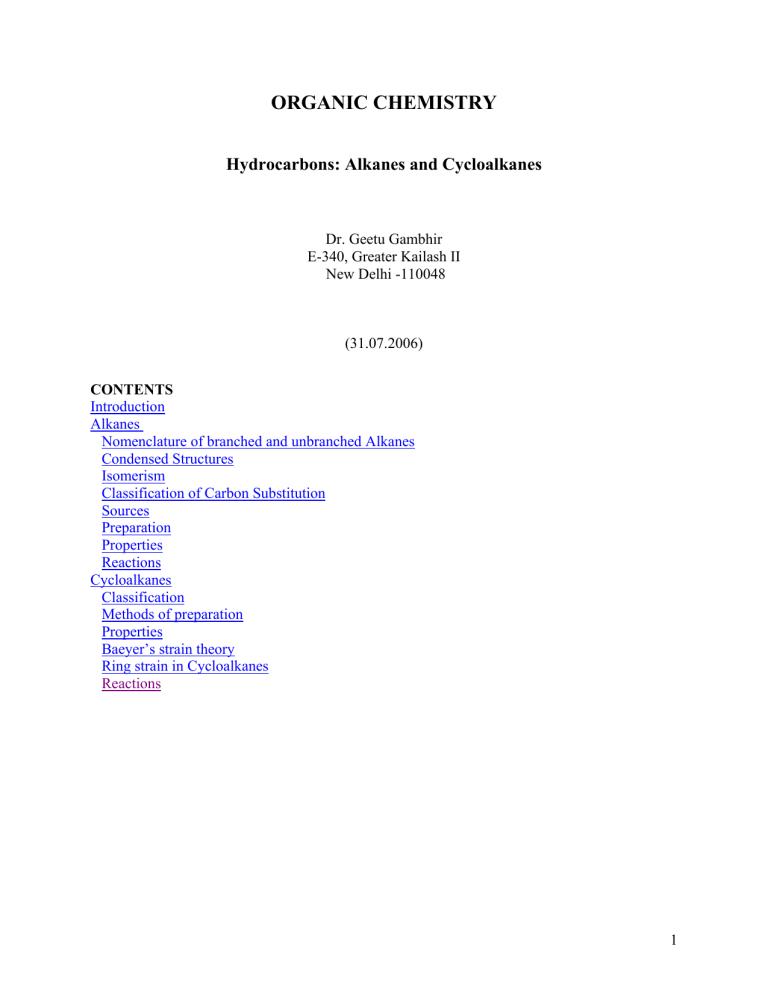
ORGANIC CHEMISTRY
Hydrocarbons: Alkanes and Cycloalkanes
Dr. Geetu Gambhir
E-340, Greater Kailash II
New Delhi -110048
(31.07.2006)
CONTENTS
Nomenclature of branched and unbranched Alkanes
Classification of Carbon Substitution
Reactions
1
Introduction
With the key element carbon, organic compounds contain large chemical diversity. They contain wide variety of elements and varisity in the structures. This is due to the unique property of carbon to form large number of compounds. This behaviour of carbon relates to:
•
Its position in the periodic table.
•
Its ability to form four stable covalent bonds and
• due to its relative small size which allows easy formation of multiple bonds.
Simplest organic compounds are the hydrocarbons,that is the compounds made of carbons and hydrogen.Hydrocarbons are divided in two broad classes,Aliphatic Hydrocarbons and Aromatic
Hydrocarbons.
Alphatic comes from the greek word aleiphatos which means fat. Fats consist of long carbon chains that belongs to aliphatic groups. This class of compounds are further classified as saturated hydrocarbon and unsaturated hydrocarbon.
Saturated Hydrocarbons or alkanes are the compounds in which each atom is bonded to four other atoms. Cycloalkanes are those saturated hydrocarbons where the carbon atoms joined to form the ring. [The term saturated comes in analogy to the saturated solution. During early studies when chemist tried to add hydrogen to organic compounds and those to which no more of hydrogen could be added were termed Saturated.]
Alkanes
•
Open chain saturated hydrocarbons contain chain of carbon atoms bonded to one another by single bonds.
•
Generic formula is C n
H
2n+2 where n is number of carbon atoms per molecule.Table 1,lists the name and formula of the first few members of the series.
•
Simplest alkane is methane (CH
4
) Ethane C
2
H
6,
Propane C
3
H
8 are the subsequent member of the alkane homologus series.
•
Structure consists of SP
3 hybridized carbon atom, sharing each electron pair with the four hydrogen or carbon atoms.The four equivalent covalent bonds are directed along the four corner of the tetrahedron.
•
The structural isomerism of a given molecular formula explains the existence of two or more arrangement of the atoms,in the compound. This accounts for the existence of branched and unbranched alkanes. When carbon atom in an alkane is bonded to more than two other
2
carbon atoms, a branch in the carbon chain occurs at that position. The smallest branched alkane has four carbon atoms.
Nomenelature of Branched and Unbranched Alkanes
A professional association of chemists “International Union of Pure and Applied Chemistry
(IUPAC)”,developed and sanctioned several systems of nomenclature. Today most widely applied system is called substitutive nomenclature.
Alkanes are named by applying the following rules in order.
1. The unbranched alkanes are named according to the number of carbons.Some of these are
listed in Table 1.
Table 1
Mol Formula Condensed Structural Formula Name
CH
4
CH
4
Methane
C
2
H
C
3
H
8
6
C
4
H
10
CH
3
- CH
3
Ethane
CH
3
CH
2
CH
3
Propane
CH
3
CH
2
CH
2
CH
3
Butane
C
5
H
12
C
6
H
14
C
7
H
16
CH
3
(CH
2
)
3
CH
3
Pentane
CH
3
(CH
2
)
4
CH
3
Hexane
CH
3
(CH
2
)
5
CH
3
Heptane
2. For alkanes containing branched carbon chains, determine the principle chain, where principle chain is the longest continuous carbon chain in the molecule. Identification of the principle chain is based on the connectivities of various carbons and not on the way,the molecule is written. e.g.
H
3
C- CH
2
- CH
2
- CH- CH
2
- CH
3
H
3
C- CH- CH
2
- CH
3
| |
CH
3
CH
2
- CH
2
- CH
3
Both the above structures are identical with the principle chain having six carbon atoms.
3. If two or more chains within the structure have the same length, choose the chain with greater number of branches as the principal chain. e.g.
Six Carbon Chain with One Branch Six Carbon Chain with Two Branches
4. Number the carbon atoms in the principal chain such that the first branching point gets the
lowest number.
3
5. Name each branch and identify the carbon number of the branching point on the principal
chain.
• The branching groups in general are termed as substituents and when these substitutent are derived from alkanes they are called alkyls. Alkyls are the univalent group that is formed by removal of one hydrogen atom from an alkane. Name of each alkyl group is obtained by changing suffix. “one” of the alkane with “ye”.
-H
eg. Methane (CH
4
) - CH
3
(methyl)
-H
Ethane (CH
3
- CH
3
) - CH
2
- CH
3
(ethyl)
Alkyl substituent itself can be branched. The common branched alkyl groups have special names. Some of these are listed in the table 2.
Table 2
Group Structure Name
The prefix iso or ( i-) may be used for substituents containing two methyl groups at the end of the carbon chain.Similarly prefix neo is used for the substituents containing three methyl groups at the end of the chain.Prefixes(sec- or s-),(tert- or t-) and primary indicate tertiary, secondary and primary carbon atoms.A primary or 1
°
C is bonded to only one other carbon, secondary or
4
2
°
C to two other C’s tertiary or 3
°
C to three other C’s and quartenary or 4
°
C to four other carbons as illustrated in table 2. The C of CH
4
is termed as super 1
°
.
In a given alkane the hydrogen attached to the given type of carbon is identified as 1
°
,2
°
,3
° hydrogens 4
°
H does not exist because all the four bonds of 4
°
C are linked to four other carbons.
6.
Construct the name by first writing the carbon number of the principle chain at which the substituent occurs,a hyphen,the name of the branch and the name of the alkane corresponding to the principle chain.
The name of the branch and principal chain are written as one word. For example .
7.
If the principal chain contains multiple substituents groups each substituent receives its member. The prefixes di, tri, tetra and so on are used to indicate the number of identical substituents eg:
8.
If the substituent groups are at more than one carbon of the principal chain,alternative numbering schemes are compared number by number and the one is chosen that gives the lower number at the first point of difference. eg:
2,5,5- trimethyl heptane (right)
3,3,6- trimethyl heptane(Wrong)
5
9.
Substituent groups are cited in alphabetical order in the name regardless of their location in principal chain.The prefixes di, tri etc and tert-, sec-, are ignored in alphatizing. But prefixes iso-.neo-,and cyclo are considered while alphatizing. eg:-
10. If the numbering of different groups is not resolved by other rules,the first cited group receives the lowest number. eg:
Condensed Structures
Sometimes when space is a constraint parentheses are used to form highly condensed structures. for example:can be written as (CH
3
)
4
C.
The structural formula of the condensed form (CH
3
)
2
CH-CH(OH) CH
2
CH
3 can be written as
S ome of the examples are.
1.
2,3,4-trimethylpentane
2.
2,2-dimethylpentane
6
3.
4.
5.
Isomerism in Alkanes
•
Methane is the simplest member of the family having formula CH
4
, where a single arrangement of hydrogen atoms around the central carbon is to be seen.
•
Higher up in the series,the fixed bond angles and bond length do not limit to single arrangement of atoms of one carbon atom with respect to other. This can be visualized by the Newman and the Sawhouse projections (discussed earlier).
•
Keeping the atoms about one carbon atom fixed and rotating the C-C bond such that position of the groups about the second Carbon atom changes by every n
°
rotation.
We would observe that we get n different orientation due to rotation about C-C bond.These isomers obtained are called conformational isomers.
•
Arrangement I is called eclipsed and II is staggard having the dihedral angle (angle of rotation or angle of torsion) zero and 60
°
respectively.
•
If the rotatiom is free then, as the dihedral angle changes, energy content of the molecule will remain constant. However, it is observed that this is not the case.
7
•
The internal rotation is hindered by small repulsive interactions between the electrons in eclipsed C-H bonds on adjacent carbons do exist. These repulsive forces between bonds on adjacent atoms, which restrict rotation are called torsional strain.
•
The potential energy curve obtained for ethane is shown in the fig.
•
Potential energy of the molecule is minimum for the staggard conformation, increases with rotation and reaches maximum at the eclipsed conformation.
•
Most ethane molecules spend most of the time in more stable staggard conformation. The energy barriers of 3kcal is however not very high and even at room temperature fraction of collisions with sufficient energy is large enough for rapid interconversion.
•
Next number of the family is propane. Here the rotation occurs about the C-C bond, but the
H on one of the carbon is substituted with Me. Although Me groups is considerably larger than hydrogen the rotational barrier (3.3 kcal/mole) is only slightly higher, and is chiefly due to the torsional strain.
•
Considering butane, there are two possible structures.
•
In structure I each carbon is linked to another in a straight chain and no carbon is bonded to more than two carbon atoms. In structure II one of carbon is linked to three other carbon atoms, or one of the Me, serves as a branch to the principal chain. The two structure have same molecular formula (C
4
H
10
) but cannot be coincided as a same molecule by any amount of rotation or twisting of bonds. These two are isolated as two different compounds and are related to each other as structured, isomers with different physical and chemical properties.
The straight chain structure is called n butane and branched chain as iso-butane.
• n-Butane, like other alkane members, shows conformational isomerism.
Focusing on the rotation about C
2
-C
3
bond, we see the molecule similar to ethane but for two hydrogens replaced by Me. The different important conformation seen here are.
8
•
The gauche conformer has the Me groups (dihedral angle 60
°
) closer to each other leading to greater torsional strain than in anti conformer (dihedral angle 180
°
), where they are separated as much as possible.
•
The eclipsed conformation with two Me groups exactly eclipsing each other posses highest potential energy.
•
The anticonformation of butane is more stable than gauche by 0.9 kcal/mole.
•
The ratio of two conformers at room temperature is 4.6/1 implying 82% are in anticonformation and 18% in the gauche conformation although they are rapidly interconverting.
•
As the temperature increases the T
∆
S term in
∆
G =
∆
H + T
∆
S becomes less easily ignored.
There are two gauche conformations while only one anti form. As a result
∆
S becomes more negative and in turn
∆
G is more positive or less negative and kequi is smaller. As a result equilibrium shifts, resulting in larger concentration of gauche conformer.
Classification of Carbon Substitution
As already discussed there are different types of carbon substitutions in branched compounds. A carbon is primary (1
°
), secondary (2
°
), tertiary(3
°
) or quartenary (4
°
) when it is bonded to one, two, three or four carbons respectively. The hydrogens attached to each type of carbons are called primary, secondary & tertiary hydrogens. Note there are no quartenary hydrogens as the four bonds of quartenary carbon atom are linked to carbons only.
Sources
•
The principal natural source of alkane is petroleum (Latin word for rock and oil thus oil from rocks) or crude oil. These are isolated by the method of fractional distillation, were the more volatile fractions distill out first followed by the fractions with higher boiling point.
•
The another important source is natural gas which is chiefly constituted of alkanes with low molecular weight i.e. chiefly methane followed by ethane, propane, isobutane, etc.
•
To make lot of petroleum fractions commercially viable to meet the increasing demands of the markets, these fractions are converted into other kind of chemical compounds using different methods.
•
Catalytic isomerisation changes straight chain into branched chain compounds which serve as better motor fuels.
•
The process of cracking converts higher alkanes into smaller alkanes and alkenes and thus increase the gasoline yield.
9
•
Catalytic reforming is the method used to convert alkanes and cyclo alkanes into aromatic hydrocarbons.
Preparation of Alkanes
Apart from the natural sources which serve as the prime producers of hydrocarbon, number of other methods of synthesis of the alkanes has been designed.
1.
Hydrogeneration of alkenes : When the solution of alkene is stirred in the atmosphere of hydrogen in presence of catalyst like firmly divided platinum supported on carbon, [or by passing the vapours of the organic compound mixed with hydrogen over Ni heated at 200
°
C -
300
°
C (by Sabatier Senderens reaction)] addition of hydrogen takes place on the alkene double bond.
10
2. From alkyl halides
(i) Reduction of alkyl halides by using metal and acid .The reduction is believed to take place by transfer of electron from metal to substrate followed by abstraction of protons from the solvent.
(ii) Reduction by use of variety of reducing agents like Lithium, aluminiumhydride (LiAlH
4
),
Sodium borohydride (NaBH
4
) triphenyl, tinhydrides (Ph
3
SnH).
(iii). By hydrogenation of alkyl halides in presence of catalyst like Pd-C, Raney Nickel.
(iv) Wurtz Reaction coupling of alkyl halides with sodium in dry ether to give hydrocarbons.
Two mechanism are proposed.
•
Nucleophillic substitution : Carbanion is generated by the reaction of alkyl halide with active metal sodium, which acts as a nucleophile to attack the second molecule of alkyl halide.
•
Radical Mechanism :
(v). Grignard reagent : Alkyl Magnesium halides formed by the reaction of Mg with alkylhalides in dry ether react with any compound having labile hydrogen. eg: NH
3
,
ROH, to decompose grignard reagent to alkanes.
(vi). Corey House Synthesis : Organocopper compounds can be well utilized for formation of carbon – carbon bond but are unstable. Therefore they are generated in situ from organolithium compounds, and exist as complex aggregates (R
2
Cu
-
Li
+
). The alkyl group R is transferred from Cu, taking the pair of e
-
with and it gets attached to R` in alkyl halide.
11
3) Aldehydes and ketones can be reduced to alkanes by i) Clemmensen reduction using amalgamated zinc and concentrated HCL ii) Wolff Kishner Reduction: The carbonyl group in presence of hydrazine and sodium ethoxide forms alkanes.
4.
Carboxylic Acids: Alkane can be prepared by
(a) Decarboxylation : by heating the mixture of sodium salt of carboxylic acid with soda lime.
(b) Kolb’s electrolytic method : Reaction proceeds by free radical mechanism .It is a decarboxylation dimerization via free radicals
Properties
Physical Properties:
•
In general alkanes from C
1
to C
4
are colourless gases,C
5
to C
7
are colourless liquids and the higher members are solids.
•
Molecular weight and structure of the organic compound plays an important role in explaining the variation in physical constants.
•
Regular change in the boiling point of 20-30
°
per carbon atom for the unbranched alkanes is observed. However, the difference of b.p. decreases as higher homologus are reached. Large molecules have higher b.p. Increase in b.p can be explained as due to increase in Van der
Waal’s attraction with increase in surface are a of interacting electron cloud.
•
Increase in branching lowers the boiling point because the molecule approaches spherical properties and the less surface area is present to other molecules, for Van der Waals attraction. Hence, the boiling points tend to be lower for branched molecules.
12
•
The melting point of the unbranched alkanes with even number of carbon atom are more than those for the alkanes with odd number of carbons. This is explained by the fact that their is more effective packing of even carbon alkanes in the crystalline structure. Similar explanation holds good for the branched alkanes where branching interferes with the regular packing in the crystal and therefore, branched alkanes show lower melting point.
•
Alkanes being non polar are practically insoluble in water but are soluble in the non polar organic solvents like petrol, benzene. These class of compounds have considerably lower densities than water. They form two distinct layers with water, with less dense layer of alkane on the top.
Chemical Properties:
As the latin name “paraffins” (meaning: not enough affinity) of alkanes suggests, this family of hydrocarbons show low reactivity. Most reactions occur under vigrous conditions and yield mixture of products.They react with highly reactive substances mostly by free radical mechanism where in the reactive species abstracts the hydrogen from some part of the molecule and the alkane is transformed to a product .
Reactions
Halogenation : It takes place by free radical chain mechanism. The reaction is initiated by heat and light (which is required to break the x-x bond to x )
Mechanism:
•
Reactivity of the halogens follow the order
F
2
(explosively) >Cl
2
>Br
2
>I (does not react)
•
Number of isomeric products can be formed from a single alkane depending upon which H of alkane is substituted. eg;
13
•
Relative amounts of the isomers formed largely depends upon the halogen used:Chlorination of alkanes gives the mixture of isomers with neither of them in predominant yields.
However, bromination is more selective with predominant formation of one of the isomer.
Reason: High selectivity of bromination in alkanes is explained by Hammonds postulate.
According to the postulate transition state of endothermic bromination resembles the intermediately formed alkyl radical. Therefore TS has more of free radical character. Henceforth alkyl radical stability plays a larger role in determining the selectivity regarding various types of
C-H bonds in bromination. For example, in radical bromination of 2-methyl propane, a tertiary alkyl radical (B) is much more effectively generated by bromine radical attack than the primary alkyl radical (A).
In contrast, in exothermic chlorination the transition state structure resembles that of starting material. Due to high electro-negativity of chlorine the reactant is attached at an early stage of the reaction, namely when C-H bond has still not been heavily altered. Therefore the transition state largely resembles the starting products. The radical character is more or less evenly distributed among carbon and chlorine. e.g. chlorination of 2-methyl butane. Hence stability of alkyl radical does not play the determining role for high selectivity.
•
The isomer formed depends upon the
¾ abstraction of H from the parent hydrocarbons. Ea (Activation energy) for the abstraction of hydrogen follows the order 3
°
<2
°
<1
°
.
Reason : Abstraction of H depends upon the stability of the radical formed after abstraction. Since the stability of the radicals is tertiary > sec > primary therefore the above order of abstraction of H is observed. eg: for Chlorination relative rate per hydrogen atoms are 5.0 : 3.8 : 1.0 for tertiary, secondary and primary hydrogen.
14
¾
Apart from stability of the radical formed, another factor is the probability factor, i.e. the availability of the given hydrogen at the time of reaction. for example in propane
The probability factor favours the abstractions of primary hydrogen by ratio 3:1.
For example: Chlorination of propane.
•
Rearrangement of the free radicals do not take place as it takes in carbocations. Therefore the isomeric products are formed as per the relative rates predicted.
•
Iodination of alkanes is reversible reaction but can be carried out in the presence of an oxidizing agent like HIO
3
HNO
3
etc. eg:
CH
3
–CH
3
+ I
↔
CH
3
CH
2
I + HI
5HI + HIO
3
→
3I
2
+ 3H
2
O
•
Overall halogenation of alkanes is not a suitable method of preparation of alkyl halides because in chlorimation no isomer is formed in predominance and it is difficult to separate the isomers.
Nitration : Alkanes (in vapour phase) reacts with nitric acid at the temperature between 150
°
to
475
°
C to yield the mixture of mononitroalkanes. Nitration takes place by free radical mechanism where by the H of alkane is replaced by the nitro group. e.g.
•
Liquid phase nitration under pressure at 140
° c with cone.HNO
3
gives mostly a mixture of polynitrated products.
•
Substitution of Hydrogen by nitro group follows the order, t-H>s-H>p-H.
Sulphonation : treatment of alkane with forming fuming acid (H
2
S
2
O
7
or H
2
SO4/SO
3
) replaces the H of the alkane by sulphonic acid group to yield alkyl sulphonic acids.
•
Ease of replacement of H follows the order t > s > p.
15
Oxidation:
•
Alkanes undergo combustion in excess of oxygen to form CO
2
and H
2
O and large amount of heat is liberated.
•
This is the reason for tremendous importance of alkanes as fuel
•
Controlled oxidation under different conditions yield different products like acids, ketones and alcohols.
•
Oxidation in vapour state occurs via free radicals, eg : alkyl (R
°
), alkyl peroxy ( R00
°
), alkoxy
(R0
°
).
Isomerisation : Straight chain alkanes can be isomerised to branched hydrocarbons by heating in
AlCl
3
at 300
°
C. eg: n butane to iso butane.
Pyrolysis/Cracking: Thermal decomposition of alkanes is called pyrolysis. When alkanes are heated to a high temperature, both C-H and C-C bonds rupture.In absence of oxygen resulting radicals may combine to form new alkanes or abstract H from another radical center to form alkene.
Catalytic cracking is the process of breaking larger molecules of petroleum into smaller fractions by use of finely divided silica alumina catalyst at 450-550
°
C and small pressure. This mechanism of cracking proceeds through carbocation resulting in fairly good yield of branched alkanes and alkenes ( Superior fuels).
16
Cyclo Alkanes
Hydrocarbons containing single bonded carbon atoms arranged in rings are cyclo alkanes (or, carbocycles)
General formula : C n
H
2n
Classification of saturated cycloalkanes
Size of the ring
And the ring strain
Number of rings
– C
4
)
Common
5
– C
6
) Monocyclic Polycylic
– C
12
)
Large rings (>C
12
)
Fused
Bridged C’s
Spiranes
Monocyclic Saturated Alkanes
IUPAC Nomenclature : System of naming the saturated monocyclic hydro carbons follow the same rules as corresponding open chain saturated hydrocarbon (alkanes), preceded by the prefix cyclo. For example: lowest member of the series is cyclo propane
For substituted cyclo alkanes
(a) For mono substituents, carbon of attachment is given the number 1 of the ring carbons.
(b) For Polysubstituted compounds : i.
Give lowest possible numbering sequence. ii.
For two same sequences, alphabetical order of substituents name is followed. iii.
Smaller unit is treated as substituents. iv.
Radical derived from cycloalkanes by abstraction of hydrogen are called cyclo alkyl radicals.
17
Polycylic
The rings that share common C-C bond are said to be fused. The function points are called bridge head carbons e.g.
•
Bridge C’s are in chain connecting but not including the bridge head C;s. In norbornane one bridge C separates the bridge head carbon atoms.
IUPAC nomaclature : eg.: norbornane. The prefix bicyclo with pair of brackets enclosing the number showing the number of carbons in each bridge are written in decreasing order, followed by the name of alkane whose number of carbons equals the number of carbons in the rings.
Spiranes :- are the poly cyclics that share only one carbon atom.
Isomerism:
Due to restricted free rotation about carbon. carbon bond in rigid structure of cyclo alkanes they show geometrical isomerism. Therefore the disubstituted cyeloalkanes show two isomers. When the two same substituents (or different substituents of higher lower priorities) are positioned on same side, they are called cis isomer, while these on opposite side are called trans isomer.
They also show structure isomersism therefore large number of isomers can be possible for any compound eg.
18
Since this particular isomer has a chiral centre there fore it also show an optical isomer.
Methods of preparation
Two general approaches:
(a) Intramolecular cylization of monocyclic compounds
(b) Cycloadditions
Some of the general methods of synthesis for the rings of various sizes are
1.
Dihalogen derivatives when treated with sodium or zinc.
• when two halogens are further a part than 1,6 position , they lead to wurtz reaction instead of cyclization
2.
Distillation of Ca/Ba salt of dicarboxylic acid to give cyclic ketones which undergo
Clemmensen reduction to give cycloalkanes.
3.
Condensation of certain dihalo alkanes with compounds with active methylene group like sodium acetoacetic ester or malonic ester for eg.
4.
Dieckmann Cyclization : It is an intramolecular Claisen condensation used for synthesis of five six or seven membered cyclic hydrocarbons.
19
Esters of the lower acids reacts by intermolecular condensation. for example.
5.
Hydrogenation : Addition of hydrogen to aromatic compounds yield cyclic aliphatic compounds
6.
Diel’s Alder reaction : It is a cycloaddition reaction. It involves 1, 4 addition of an alkene to a conjugated diene to form an adduct. The reaction is initiated by heat or lewis acids.
7.
Cycloaddition through carbene intermediate
20
Properties
Physical properties: Cycloalkanes have higher melting points because they have more compact shapes than n –alkanes and are packed more closely in the solid state. For the same reason of close packing even in liquid state these compounds are more dense than the open chain alkanes.
Chemical properties: Reactivity of two ring system is dependent on the structure of the cyclic alkane.
Structure: For any carbon connected to four other atoms the stable geometry is that of a tetrahedron with the bond angle of 109
°
28’. Cyclo alkanes are the ring structure for the formation of which , the bond angles have to be altered from the normal value of 109
°
28’. The energy needed to distort the tetrahedral carbons enough, to close the ring is called as bond angle strain – Higher is the deviation, higher is the strain in the cyclichydrocarbon and higher would be the tendency to break open chain to attain a open structure.
Baeyer Strain Theory
In 1885 Adolf Von Baeyer (of the University of Munich) proposed a strain theory according to which the deviation of bond angles from a normal tetrahedral value causes, the strain in the molecules which makes them unstable as compared to the molecules with tetrahedral angle. For example in cyclopropane or cyclobutane the rings are planar with ring bond angles of 60
°
and
90
°
respectively. This implies that the normal C – C bond has to be compressed from 109
°
28’ to
60
°
or 90
°
to fit the geometry of the ring. This explains the reactivity of these rings towards the reaction that cause ring opening to form open chain compounds to relive the angle strain.
•
Larger is the deviation larger is the strain in the molecule. Cyclo pentane has angles of regular pentagon (108
°
, very close to 109
°
28’, and is therefore almost free of strain.
Higher up the series cyclo hexane has a geometry of a hexagon (120
°
) and should have little strain. All the rings smaller or larger than cyclo pentane or cyclo hexane are unstable and therefore under go ring opening reactions.
•
Heat of combustion data for various cycloalkanes reveal the stability of these molecules .
No. of C atoms
Heat of combustion in
KJ/CH
2
3 697
4 685
5 664
6 659
7 662
8 661-665
Open chain 157.4
Total Strain (KJ)
120
112
35
12
35
32-38
-
•
Cyclo propane and cyclo butane evolve more energy per CH
2
group than an open chain compound meaning they contain more energy per CH
2
and hence less stable, which is in agreement with the Baeyer’s strain theory.
21
Discrepancy in Baeyer’s strain theory : Rings larger than cyclo pentane or cyclo hexane should be unstable. Also rings larger than C
8
show very less strain and larger one are completely free of strain. Also once synthesized these large ring cyclo alkanes show little tendency to under ring opening reactions like cyclo propane and cyclo butane.
Reason : Baeyer’s theory can not be applied to ring size greater than four. This is because the angles Baeyer’s used were based on the assumption that rings are flat eg cyclo hexane 120
°
.
How ever the cyclo hexane ring is not flat but puckered so that each bond engle is 109
°
5’ and is of all relieved the angle strain. Three and four membered ring are flat and any puckering in them would increase the strain planer five membered rings permits tetaherdal value. All the rings larger than those are puckered.
Secondly the difficulty in their synthesis is not due to their less stability. It is because the closing of the ring requires that the end of the chain be brought close enough for the bond to be formed.
Larger the size of ring longer is the size of the chain from which it is made and less likelihood of two ends of the chain to meet.
Bonding in cyclobutane & cyclo propane:
According to orbital picture a covalent bond is formed by the overlapp between the atomic obbitals of the two atoms. Larger is the overlapp, stronger is the bond. (Headon overlapp of two atomic orbital is the condition of maximum overlapping)
For SP
3
hybridized carbon atom the four hybrid atomic orbitals are directed along 109
°
28`and the maximum overlap with another SP
3 hybrid orbital takes place at this angle only.
As can be seen very poor orbital overlap takes place to achieve the bond angle of 60
°
(Cyclopropane) or 90
°
(Cyclobutane). This leads to lot of angle strain and hence decreases stability. Quantum mechanical approach therefore proposed bent bonds or banana bonds for cyclopropane ring. Carbon develops more and more of p character in the orbitals forming the ring, as bonding between p orbitals generate a bond angle at 90
°
therefore more of such bonding in ring carbon atoms decreases the strain. To get more of S character in the external bonds, bonding is somewhere between SP
2
and SP
3
leading to enlargement of angle. i.e. H-C-H bond angle of 114
°
.This also explain the shorter C-H bond in cyclopropane than in n-propane.
Ring Strains in Cycloalkanes a) Bond angle strain:caused by distortion of the tetrahedral carbon angle in closing the ring. b) Eclipsing or torsional strain:results from eclipsing of adjacent pairs of C-H bonds or any deviation from sttaggard arrangement. c) Transannular strain : Due to the close proximity of the H atoms not on adjacent carbons.
22
d) Steric strain : Groups that just touch each other, if brought further close, start repelling, such crowding causes steric strain.
•
The deviation of bond angles in cyclobutane is much less as compared to cyclopropane.yet the ring strain is not much less than that of cyclopropane due to the additional eclipsing strain.Cyclobutane has four pair of eclipsing hydrogen as compared to three in cyclopropane.
Stability of Cyclohexane
Planar cyclohexane ring has bond angles of 120
°
,considerably larger than 109
°
, therefore experiences large angle strain along with eclipsing strain from six pair of C-H bonds
Cyclohexane overcomes these strains by being puckered to give rapidly equilibrating chair conformations where it achieves nearly tetrahedral angles with no angle strain and eliminates eclipsing strain because all the H are staggard.
Reactions i) Halogenation : Cycloalkanes undergo chiefly free radical substitution.
Complex mixtures of structural as well as geometric isomers of monobrominated products are obtained. ii) Besides free radical substitution,cyclopropane and cyclobutane undergo certain addition reactions.
23
Cyclopropane undergoes ring opening reactions. (enhanced p-character of the ring bonds makes cyclopropane nucleophillic.) iii) Hydrohalogenation
Here the intermediate is a carbocation formed when H
+
adds to the ring CH
2
group.As a result stability of carbocation plays the directive influence for the formation of the product.Alkyl groups in 1,1-dimethyl cyclopropane are e
-
releasing that increases the nucleophilicity and reactivity of the ring in electrophillic additions. iv) Hydrogenation:
•
Cyclopentane and higher rings have too little strain and are therefore inert to H
2
.
24

